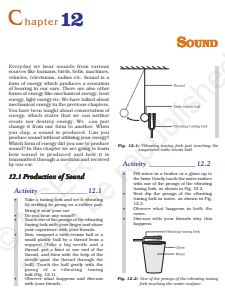‘NCERT Solutions for Class 9 Science Chapter 12‘ PDF Quick download link is given at the bottom of this article. You can see the PDF demo, size of the PDF, page numbers, and direct download Free PDF of ‘Ncert Class 9 Science Chapter 12 Exercise Solution’ using the download button.
NCERT Class 9 Science Textbook Chapter 12 With Answer PDF Free Download

Chapter 12: Sound
Every day we hear sounds from various sources like humans, birds, bells, machines, vehicles, televisions, radios, etc.
A sound is a form of energy that produces a sensation of hearing in our ears. There are also other forms of energy like mechanical energy, heat energy, light energy etc.
We have talked about mechanical energy in the previous chapters. You have been taught about the conservation of energy, which states that we can neither create nor destroy energy.
We can just change it from one form to another. When you clap, a sound is produced.
Can you produce sound without utilizing your energy? Which form of energy did you use to produce sound?
In this chapter, we are going to learn how sound is produced and how it is transmitted through a medium and received by our ear.
12.1 Production of Sound
From the above activities, what do you conclude? Can you produce sound without a vibrating object?
In the above activities, we have produced sound by striking the tuning fork. We can
also produce sound by plucking, scratching, rubbing, blowing, or shaking different objects.
As per the above activities, what do we do to the objects? We set the objects vibrating and produce sound.
Vibration means a kind of rapid to and fro motion of an object. The sound of the human voice is produced due to vibrations in the vocal cords.
When a bird flaps its wings, do you hear any sound? Think how the buzzing sound accompanying a bee is produced.
A stretched rubber band when plucked vibrates and produces sound. If you have never done this, then do it and observe the vibration of the stretched rubber band.
12.2 Propagation of Sound
Sound is produced by vibrating objects. The matter or substance through which sound is transmitted is called a medium.
It can be solid, liquid, or gas. Sound moves through a medium from the point of generation to the listener.
When an object vibrates, it sets the particles of the medium around it vibrating. The particles do not travel all the way from the vibrating object to the ear.
A particle of the medium in contact with the vibrating object is first displaced from its equilibrium position.
It then exerts a force on the adjacent particle. As a result of which the adjacent particle gets displaced from its position of rest.
After displacing the adjacent particle the first particle comes back to its original position. This process continues in the medium till the sound reaches your ear.
| Author | NCERT |
| Language | English |
| No. of Pages | 16 |
| PDF Size | 16.1 MB |
| Category | Science |
| Source/Credits | ncert.nic.in |
NCERT Solutions Class 9 Science Chapter 12 Sound
1. Which wave property determines (a) loudness, and (b) pitch?
Solution:
(a). Amplitude – The loudness of the sound and its amplitude is directly related to each other. The larger the amplitude, the louder the sound.
(b). Frequency – The pitch of the sound and its frequency is directly related to each other. If the pitch is high then the frequency of sound is also high.
2. Guess which sound has a higher pitch: guitar or car horn?
Solution:
The pitch of a sound is directly proportional to its frequency. Therefore, the guitar has a higher pitch when compared to a car horn.
3. What are the wavelength, frequency, time period, and amplitude of a sound wave?
Solution:
(a) Wavelength – Wavelength can be defined as the distance between two consecutive rarefactions or two consecutive compressions. The SI unit of wavelength is a meter (m).
(b) Frequency – Frequency is defined as the number of oscillations per second. The SI unit of frequency is hertz (Hz).
(c) Amplitude – Amplitude can be defined as the maximum height reached by the trough or crest of a sound wave.
(d) Time period – The time period is defined as the time required to produce one complete cycle of a sound wave.
4. How are the wavelength and frequency of a sound wave related to its speed?
Solution:
Wavelength, speed, and frequency are related in the following way:
Speed = Wavelength x Frequency
v = λ ν
5. Calculate the wavelength of a sound wave whose frequency is 220 Hz and speed is 440 m/s in a given medium.
Solution:
Given that,
Frequency of sound wave = 220 Hz.
Speed of sound wave = 440 m/s.
Calculate wavelength.
We know that,
Speed = Wavelength × Frequency
v = λ ν
440 = Wavelength × 220
Wavelength = 440/220
Wavelength = 2
Therefore, the wavelength of the sound wave = is 2 meters.
Sound NCERT Textbook With Solutions PDF Free Download
